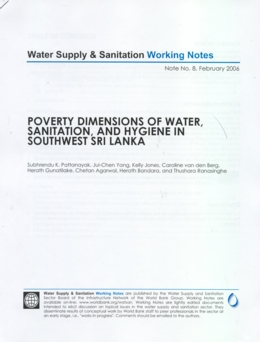|
 Halving the number of people without sustainable access to safe drinking water by 2015 is an important Millenium Development Goal. How do we design policies and projects that will efficiently and equitably help meet this goal How do we accurately monitor and systematically evaluate progress towards attaining this target By characterizing the current needs and constraints of households and service providers, the data from baseline surveys define the starting point in quantifiable terms. Collectively such information can be deployed in generating hypotheses and explanations about the behaviors of households and providers, designing incentives and directives, setting targets, defining indicators, monitoring progress toward goals, and evaluating specific programs and projects for desired outcomes. We illustrate these fetures through a case study of water, sanitation, hygiene, and poverty from coastal towns of southwest Sri Lanka. This paper illustrates the types of information generated by household and community surveys for the purposes of establishing baselines. If the PSP transaction were to be implemented in thisregion, our data could be used to monitor and evaluate the performance of such a transaction in for instance delivering WSS services to the poor. We also evaluate various “pro-poor” design issues such as service level, tariff, and subsidy options. Table of Contents: Summary 1. Introduction 2. Study Design 3. Conclusions Bibliography Annexes Post Date : 05 Juni 2009 |